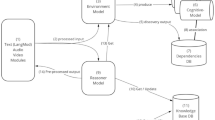Abstract
A central problem of many branches of artificial intelligence (AI) research is that ofunderstanding natural language (NL). Many attempts have been made to model understanding with computer systems that demonstrate competence at such tasks as question answering, paraphrasing, and following commands. The system to be described in this paper combines some of these language functions in a single, general process based on the creation of an associative memory net as a result of experience. The author has written a large, interactive computer program that accepts unsegmented input strings of natural language from a human trainer and, after processing each string, outputs a natural language response. The processing of the string may involve transforming it to some other form in the same or another language, or answering an input question based on information previously learned by the program.
Similar content being viewed by others
References
S. R. Jordan, “Learning to Use Contextual Patterns in Language Processing,” Ph.D. thesis, Technical Report No. 152, Computer Science Department, University of Wisconsin, March 1972.
M. R. Quillian, “Semantic Memory,” Ph.D. thesis, inSemantic Information Processing, Marvin Minsky, Ed. (MIT Press, Cambridge, Mass., 1968), pp. 227–270.
M. R. Quillian, “The teachable language comprehender: a simulation program and theory of language,”Commun. ACM 12(8):459–476 (August 1969).
R. C. Schank, “Conceptual dependency: a theory of natural language understanding,”Cognit. Psychol. 3:552–631 (1972).
R. C. Schank, N. Goldman, C. J. Rieger, III, and C. Riesbeck, “MARGIE: Memory, Analysis, Response Generation, and Inference on English,”Proceedings of the Third International Joint Conference on Artificial Intelligence, Stanford, pp. 255–261 (1973).
S. C. Shapiro, “The MIND System: A Data Structure for Semantic Information Processing” Ph.D. thesis, Project RAND Report R-837-PR (August 1971).
L. Siklossy, “Natural Language Learning by Computer,” Ph.D. thesis, Department of Computer Science, Carnegie-Mellon University, Pittsburgh, Pa. (1968).
R. F. Simmons, “Some Semantic Structures for Representing English Meanings,” University of Texas, Austin, Computer Science Department, Report NL-1 (1970).
R. F. Simmons and J. Slocum, “Generating English discourse from semantic networks,”Commun. ACM 15(10):891–905 (October 1972).
L. Uhr, “Pattern-string learning programs,”Behav. Sci. 9(3):258–270 (July 1964).
L. Uhr and G. Ingram, “Language Learning, Continuous Pattern Recognition, and Class Formation,”Proceedings of the IFIP Congress 65 (Spartan Books, Washington, D.C., 1965), pp. 333–334.
D. E. Walker, “Speech Understanding Through Syntactic and Semantic Analysis,”Proceedings of the Third International Joint Conference on Artificial Intelligence, Stanford, pp. 208–215 (1973).
Y. Wilks, “An Artificial Intelligence Approach to Machine Translation,” inComputer Models of Thought and Language, R. C. Schank and K. M. Colby, Eds. (W.H. Freeman & Co., San Francisco, 1973), pp. 114–151.
T. Winograd,Understanding Natural Language (Academic Press, New York, 1972).
W. A. Woods, “Transition network grammars for natural language analysis,”Commun. ACM 13(10):591–606 (October 1970).
Author information
Authors and Affiliations
Rights and permissions
About this article
Cite this article
Jordan, S.R. A natural language understander based on a freely associated learned memory net. International Journal of Computer and Information Sciences 6, 9–25 (1977). https://doi.org/10.1007/BF00991480
Received:
Issue Date:
DOI: https://doi.org/10.1007/BF00991480




